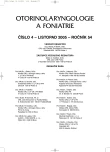-
Medical journals
- Career
The Role of Sleep Monitoring in the Diagnosis of Obstruction Syndrome of Sleep Apnea
Authors: J. Plzák 1,2,3; J. Klozar 1; M. Zábrodský 1; J. Betka 1
Authors‘ workplace: Klinika ORL a chirurgie hlavy a krku 1. LF UK a FN Motol, Praha Katedra otorinolaryngologie IPVZ, Praha ; přednosta prof. MUDr. J. Betka, DrSc. Anatomický ústav 1. LF UK, Praha 1; přednosta prof. MUDr. M. Grim, DrSc. Centrum buněčné terapie a tkáňových náhrad 2. LF UK, Praha 2; vedoucí prof. MUDr. E. Syková, DrSc. 3
Published in: Otorinolaryngol Foniatr, 54, 2005, No. 4, pp. 187-192.
Category: Original Article
Overview
Summary:
Obstructive sleep syndrome (OSAS) is characterized by repeated episodes of the upper airway obstruction, usually accompanied with oxygen desaturation. Patients suffer from increased morbidity and even mortality. They have higher incidence of hypertension, coronary artery disease, arrhythmias, and stroke.
The aim of the study was to evaluate the prediction potential of history and physical examination for OSAS/snoring diagnosis, compared to the sleep study.
123 sleep studies were carried out from February 2004 till January 2005. The correlation of history and physical examination to the sleep study was evaluated by statistical analysis.
51% of sleep studies confirmed OSAS. From the group of patients complaining of snoring but no increased daytime sleepiness were diagnosed 32% as OSAS patients. The best anamnestic predictor of OSAS was the presence of apnea, and increased daytime sleepiness. The clinical indicator of OSAS was higher level of Mallampati classification, higher age, and higher BMI.
The night sleep study is the only method to confirm and especially exclude OSAS. One third of patients complaining only of snoring were proved as sleep apnea patients. If this group would not be sent for the sleep study, patients after the treatment aimed to the snoring could develop so-called syndrome of “silent” apnea. They would stay at high risk of severe health complications due to not recognized sleep-disordered breathing. Palatal surgery could also deteriorate efficiency of CPAP (continuous positive airway pressure) in cases with conservative approach.Key words:
sleep monitoring, breathing disorders, statistical methods.
Labels
Audiology Paediatric ENT ENT (Otorhinolaryngology)
Article was published inOtorhinolaryngology and Phoniatrics

2005 Issue 4-
All articles in this issue
- Shaver (Microdebrider) in Otorhinolaryngology
- The Role of Sleep Monitoring in the Diagnosis of Obstruction Syndrome of Sleep Apnea
- Cholesteatoma and Fistula of Bone Labyrinth
- The Importance of MitoticApoptotic Index and DNA Flow Cytometry in the Prognosis of Head and Neck Cancer
- Xerostomia: Etiology, Therapeutic Possibilities, Recommendation to Patients
- Anomalous Course of Internal Carotid Artery as a Cause of Massive Perioperative Hemorrhage from Middle Ear
- Langerhans‘ Cell Histiocytosis and Its Manifestation in Temporal Bone (Eosinophilic Granuloma of the Temopral Bone)
- Otorhinolaryngology and Phoniatrics
- Journal archive
- Current issue
- Online only
- About the journal
Most read in this issue- Xerostomia: Etiology, Therapeutic Possibilities, Recommendation to Patients
- Shaver (Microdebrider) in Otorhinolaryngology
- Langerhans‘ Cell Histiocytosis and Its Manifestation in Temporal Bone (Eosinophilic Granuloma of the Temopral Bone)
- Cholesteatoma and Fistula of Bone Labyrinth
Login#ADS_BOTTOM_SCRIPTS#Forgotten passwordEnter the email address that you registered with. We will send you instructions on how to set a new password.
- Career

